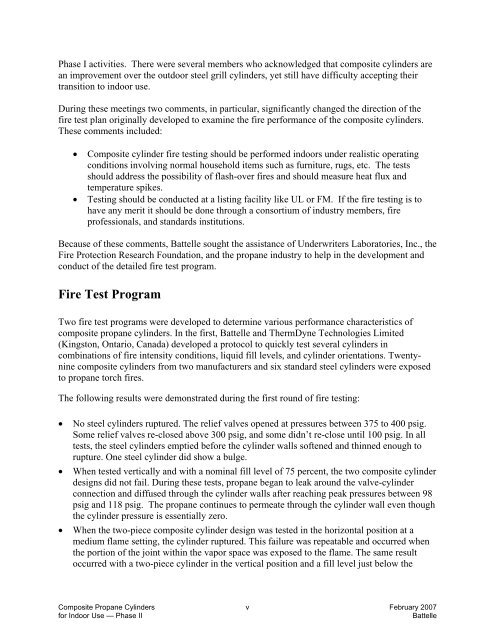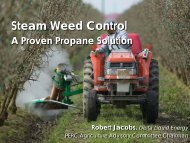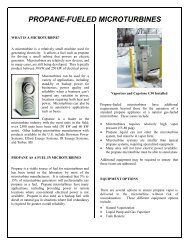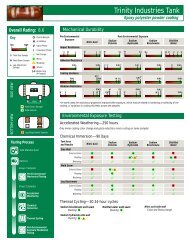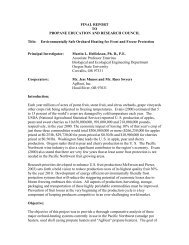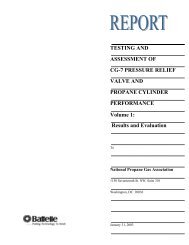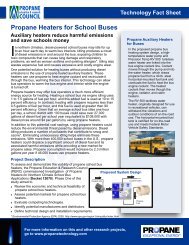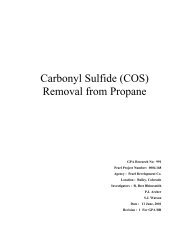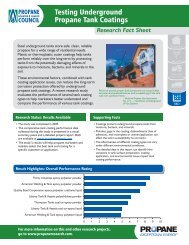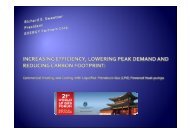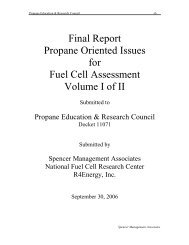Code Approval of Composite Propane Cylinders for Indoor Use ...
Code Approval of Composite Propane Cylinders for Indoor Use ...
Code Approval of Composite Propane Cylinders for Indoor Use ...
You also want an ePaper? Increase the reach of your titles
YUMPU automatically turns print PDFs into web optimized ePapers that Google loves.
Phase I activities. There were several members who acknowledged that composite cylinders arean improvement over the outdoor steel grill cylinders, yet still have difficulty accepting theirtransition to indoor use.During these meetings two comments, in particular, significantly changed the direction <strong>of</strong> thefire test plan originally developed to examine the fire per<strong>for</strong>mance <strong>of</strong> the composite cylinders.These comments included:• <strong>Composite</strong> cylinder fire testing should be per<strong>for</strong>med indoors under realistic operatingconditions involving normal household items such as furniture, rugs, etc. The testsshould address the possibility <strong>of</strong> flash-over fires and should measure heat flux andtemperature spikes.• Testing should be conducted at a listing facility like UL or FM. If the fire testing is tohave any merit it should be done through a consortium <strong>of</strong> industry members, firepr<strong>of</strong>essionals, and standards institutions.Because <strong>of</strong> these comments, Battelle sought the assistance <strong>of</strong> Underwriters Laboratories, Inc., theFire Protection Research Foundation, and the propane industry to help in the development andconduct <strong>of</strong> the detailed fire test program.Fire Test ProgramTwo fire test programs were developed to determine various per<strong>for</strong>mance characteristics <strong>of</strong>composite propane cylinders. In the first, Battelle and ThermDyne Technologies Limited(Kingston, Ontario, Canada) developed a protocol to quickly test several cylinders incombinations <strong>of</strong> fire intensity conditions, liquid fill levels, and cylinder orientations. Twentyninecomposite cylinders from two manufacturers and six standard steel cylinders were exposedto propane torch fires.The following results were demonstrated during the first round <strong>of</strong> fire testing:• No steel cylinders ruptured. The relief valves opened at pressures between 375 to 400 psig.Some relief valves re-closed above 300 psig, and some didn’t re-close until 100 psig. In alltests, the steel cylinders emptied be<strong>for</strong>e the cylinder walls s<strong>of</strong>tened and thinned enough torupture. One steel cylinder did show a bulge.• When tested vertically and with a nominal fill level <strong>of</strong> 75 percent, the two composite cylinderdesigns did not fail. During these tests, propane began to leak around the valve-cylinderconnection and diffused through the cylinder walls after reaching peak pressures between 98psig and 118 psig. The propane continues to permeate through the cylinder wall even thoughthe cylinder pressure is essentially zero.• When the two-piece composite cylinder design was tested in the horizontal position at amedium flame setting, the cylinder ruptured. This failure was repeatable and occurred whenthe portion <strong>of</strong> the joint within the vapor space was exposed to the flame. The same resultoccurred with a two-piece cylinder in the vertical position and a fill level just below the<strong>Composite</strong> <strong>Propane</strong> <strong>Cylinders</strong> v February 2007<strong>for</strong> <strong>Indoor</strong> <strong>Use</strong> — Phase IIBattelle


